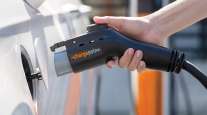Contributing Writer
Study Tallies Massive Growth in Electric Truck Orders

[Stay on top of transportation news: Get TTNews in your inbox.]
Electric trucks comprise a fraction of the commercial vehicle fleet in the U.S., but orders in the pipeline — including one from a prominent online seller — could make the numbers spike in coming years, a study said.
According to the Zeroing In On Zero Emissions Trucks report released Feb. 3 by Calstart, a Pasadena, Calif.-based coalition that promotes zero-emission trucks, there currently are 140,000 pending orders for commercial EVs, predominantly delivery vehicles.
The bulk is an order for 100,000 electric delivery vans from Rivian by Amazon, while Walmart has reserved 5,000 of BrightDrop’s EV600 and smaller EV410 electric delivery vans from General Motors. FedEx also reserved 2,000 vehicles from BrightDrop, and is negotiating to add up to 20,000 more.

General Motors has reservations for thousands of its Brightdrop EV600 delivery vans from FedEx and Walmart. (General Motors)
“We are hoping to see 30% of new sales nationally by 2030, and much higher for the Class 2 trucks,” Kevin Walkowicz, Calstart’s senior director of truck and off-road initiative, told Transport Topics.
Expected delivery times of the 140,000 vehicles on order are between one and 10 years, Calstart said.

Walkowicz
There are 1,215 zero-emission trucks – almost all battery-electric vehicles – now in use in the U.S., the report said. That’s just 0.005% of all medium- and heavy-duty trucks in the U.S. However, Calstart sees increased product offerings from truck manufacturers, more government subsidies and regulations requiring a transition from diesel trucks as factors pushing EV adoption.
While 163 customers have deployed the trucks, most – 78% – are logistics providers and private fleets. The remainder are operated by governments, primarily cities and school districts, according to Calstart. Just 20 customers accounted for 50% of zero-emission truck deployments as of year-end.
California leads the nation in adoption, with 738 zero-emission trucks and yard tractors in use at the end of last year, according to Calstart. Another 14 states and the District of Columbia – all part of a memorandum of understanding with California to deploy zero-emission vehicles — have another 248.
Most of the vehicles are in demonstration projects or pilot programs to provide early adopters information about cost of operation, durability, range and charging requirements. All are battery-electric except for a small number of hydrogen fuel cell tractors undergoing regional haul testing in Southern California.
Calstart said there are 145 zero-emission truck models available, mostly in Classes 3 through 6 and retrofitted with EV powertrains integrated into existing chassis.

Host Seth Clevenger speaks with Neil Shelton of GXO and Cathy Roberson of the Reverse Logistics Association about the supply chain. Hear a snippet above, and get the full program by going to RoadSigns.TTNews.com.
The initial Class 8 offerings from Daimler Trucks, Volvo Trucks and Paccar rely on platforms designed for diesel engines but converted to electric powertrains.
Several California initiatives also will grow the count, including orders for 1,200 supported by the state’s incentive voucher program and another 280 Class 8 battery-electric and fuel cell tractors as part of an Air Resources Board program.
Manufacturers including Volvo, Daimler and Paccar are entering the heavy-duty electric truck market, while established automakers such as GM and Ford are bringing out small and medium-duty vans and trucks, Walkowicz said.
Some early entrants have contributed to an uneven track record for earlier technology. The Calstart tally of orders and vehicles in operation includes manufacturers such as Smith EV and Workhorse group, who have either gone out of business or are struggling to deliver product.
“This is a good snapshot of where we are now, but there are going to be starts and stops, and we will see who can really produce vehicles at a competitive price and who will drop out of the business,” Walkowicz said.
California said at least 165 of the 465 electric trucks produced by Smith EV are considered non-operational, according to the report. Calstart estimates 60% of the zero-emission trucks deployed nationally are non-operational.
Want more news? Listen to today's daily briefing above or go here for more info
However, newer units are proving reliable for early adopters such as Penske Truck Leasing and for-hire carrier NFI, who report being pleased with the technology. The biggest hitch, they say, is the time required to install charging infrastructure. According to the report, newer trucks are built with improved battery chemistry, operational range and performance capabilities.
Calstart and environmental groups see EV adoption as critical for addressing pollution and global warming. Medium- and heavy-duty trucks comprise 8% of vehicles on U.S. roads but create 32% of on-road greenhouse gases, 63% of smog-forming nitrogen oxide and 68% of the particulate matter of 2.5 microns or smaller generated by roadway transportation, the report said.
Truck builders are under increasing regulatory pressure to replace diesel models with electric or fuel cell trucks. California plans to require manufacturers to sell between 40% and 75% zero-emission trucks by 2035.
The U.S. lags other countries in adoption. Europe has deployed about 2,300 zero-emission vehicles while China has about 20,000 on its roads, according to the report.
The California Air Resources Board and the state’s Zero-Emission Truck and Bus Voucher Incentive Project funded the study. Calstart plans to issue periodic updates as the market matures, Walkowicz said.




